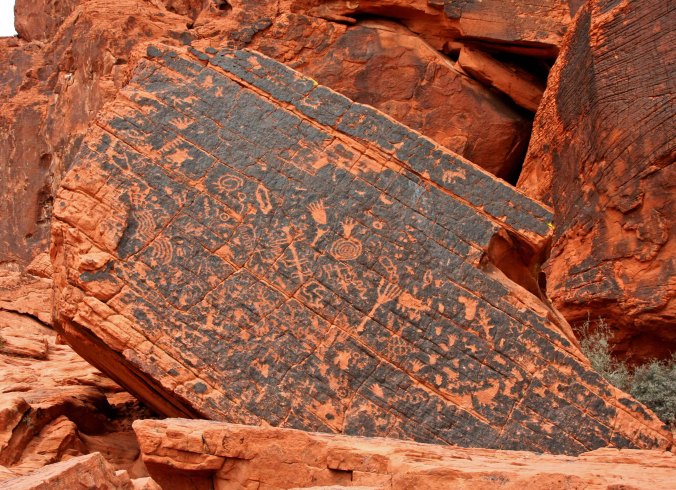
Imagine walking around a corner and coming on this wall of petroglyphs. The red sandstone provided a dramatic canvas for early artists. (Photo by Peggy Mekemson.)
I first became aware of art from traditional cultures as a Peace Corps Volunteer in Liberia, West Africa. The power of its simplicity and almost magical connection with another world caught my imagination– as it had artists such as Picasso and Matisse in the early 1900s. I collected several pieces and brought them home. Two of my favorites are the medicine mask and the bush devil shown below.
It was a natural transition for me to like and appreciate the rock art of Native Americans in the Southwestern United States. Found in hundreds of locations, it reflects several thousand years of cultural traditions. The arid climate of the Southwest combined with the fact that petroglyphs are carved in stone has allowed for their preservation. Only modern man with his graffiti poses a threat.
The Valley of Fire State Park near Las Vegas, Nevada hosts a significant collection of petroglyphs. The rock art was created by a culture known as the Basket makers (2000-1450 years ago) and the Anasazi/Ancient Pueblo group (1500-850 years ago). The Anasazi lived throughout the Southwest and were responsible for creating the impressive cliff dwellings at Mesa Verde National Park. They mysteriously disappeared around 1300, a fact which still has archeologists searching for answers.
The majority of the petroglyphs at Valley Of Fire are found at a site named Atlatl Rock by the park. The atlatl was a carved stick used for throwing spears and is featured in petroglyphs at the site. A steep, metal stairway leads up to the petroglyphs. Most tourists stop, climb the stairs and then hurry on their way. Walking a few hundred feet in either direction, which most tourists don’t do, leads to the discovery of hundreds of other petroglyphs– and Chuck. Following is a sample of what we found on our walk-about.
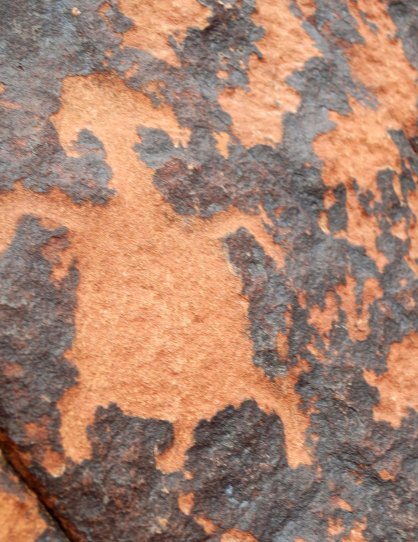
The dog– or what I think is a dog, is located in the photo above on the left beneath what may be a river.
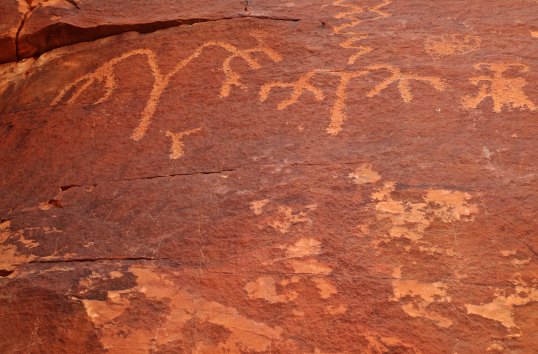
I have never seen such a direct representation of trees in petroglyphs. It is possible they are being struck by lightning. And check out the strange horned being on the right. He likely has shamanistic connections.
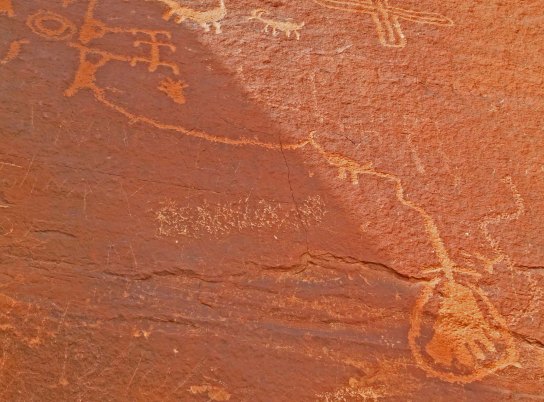
I am intrigued by this petroglyph. The figure in the upper left is using an atlatl to launch a spear. But follow the line down. It starts from his left leg, passes through what appears to be a fox or coyote, and then becomes a big foot. How would you interpret this? On the left, you can see graffiti scratched on the stone by more recent visitors.
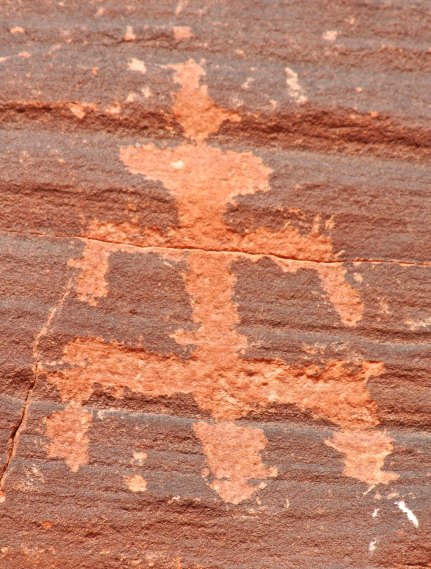
Early rock artists could be quite graphic in their depictions. This shows a child being born. I like to think of it as an early day birth announcement: “Big Bear and Bird Song are proud to announce the birth of their first daughter…” Not sure what the bird is doing sitting on her head. Maybe it’s a singing telegram. (Photo by Peggy Mekemson.)
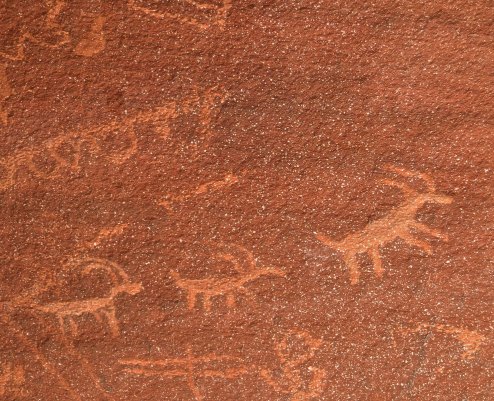
Big horn sheep, from our experience, are the most common animal found on Southwest petroglyphs, which speaks to their importance, probably as a food source.
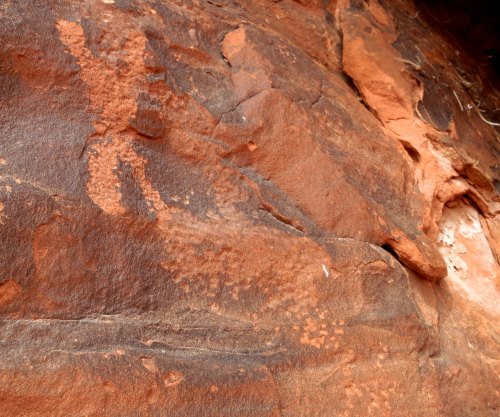
Given that donkeys weren’t around in North America when this petroglyph was created, I don’t have a clue what this animal is. The ears may be antlers, but even then… Any ideas?
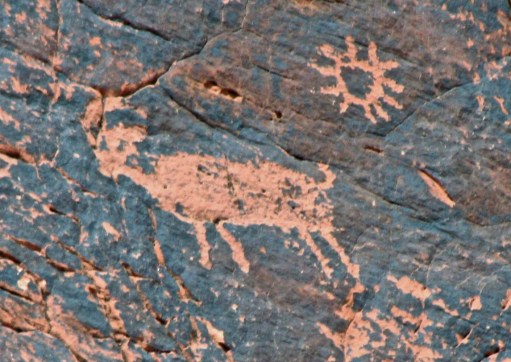
The sun is shining down on this big horn sheep. What surprised me were the eyes. It is unusual to see eyes on an animal petroglyphs. (Photo by Peggy Mekemson.)
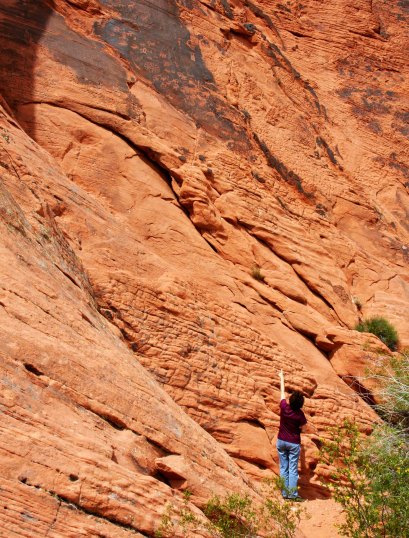
We often find petroglyphs perched high up on cliffs and marvel at the rock artists ability to climb up and do their work.
NEXT BLOG: On to Red Rock Canyon.
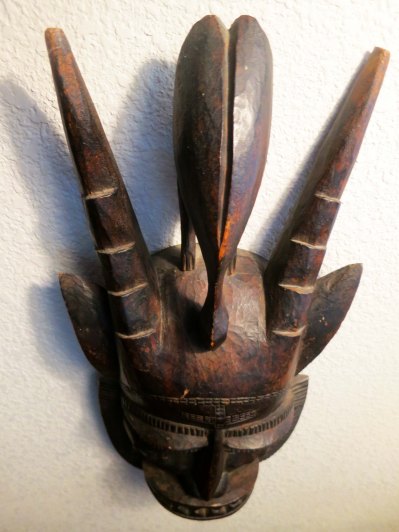
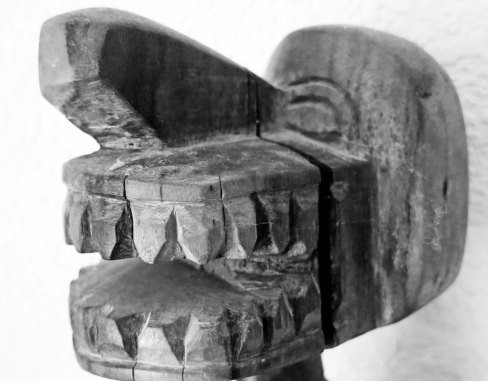
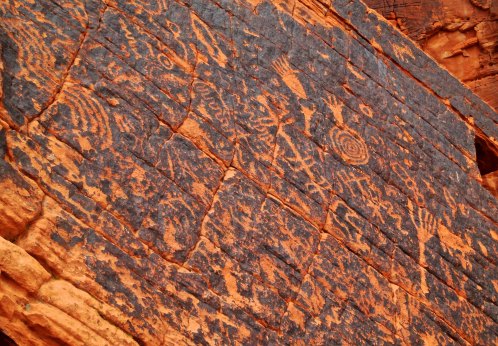
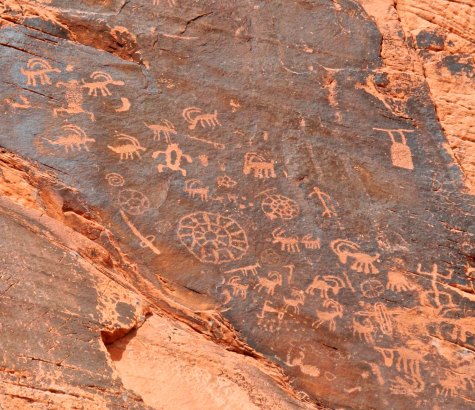
Very cool!
Thanks. –Curt
Fascinating post!
Thanks Cindy. I recall that you like petroglyphs. –Curt
I found these mesmerising. I began to imagine the carvers and the pleasure of concentration to create the images. You have probably read Jared Diamond’s Collapse: how societies choose to fail or survive – if not I am certain you would enjoy it.
I read “Gun, Germs and Steel” Hillary, but not “Collapse.” I’ve about worked my way through my present nonfiction pile. I’ll take a look at it.
I’ve certainly found rock art fascinating, for both its art form and message. (Whatever it is.) Some themes are common, such as the big horned sheep. Others, like the little fat dog, I have only seen in one other place. The quality, like all art, also varies tremendously. –Curt
That was a rich journey. Thank you. I saw things I would not have if you hadn’t pointed them out. I think that man got his foot et off by that nasty little fox 🙂
Very strange, whatever the reason. We can only wonder. But nasty little fox works. 🙂 And it’s true the more you look at those walls of petroglyphs, the more you see. –Curt
Curt… Since you are famous after being Freshly Pressed, can you please talk with the WordPress folks and get their Android app to work right for me? 😈
I enjoyed reading about your literal side trip. After a couple of irritating attempts to enlarge your photo, I was able to finally see the dog under the river! And as I blew up one other image, I saw new modern age grafitti left by non-PC punks. That was real depressing to see…
I do remember the “Rembrandt” who left that alien artwork. It was so much more artsy than all of these petroglyphs…
I did marvel at your comment about the petroglyphs drawn on higher elevations. You would think they used scarce wood strung together with some kind of woody twine? Or was it Scotty?
Indeed, you and Peggy are truly enjoying life which makes me smile.
Wow, it looks as if this is going to post!
Laughing about the “post,” Koji.
I thought of scaffolding, in a humorous way. But here are two other thoughts. One, there was a crack leading up to the site that a serious rock climber might scoot right up. Not me. Two, Anasazi homes located in caves found on unclimbable cliffs are fairly common throughout the Southwest. Theory is that the location was for defense purposes. Ladders that could be pulled up provided access. Petroglyphs often show ladders, very tall ladders. 🙂 It’s possible these were also used for making petroglyphs on otherwise unreachable sites.
I think a whole PhD in art or archeology might be done on the Rembrandts of the petroglyph world. We have certainly seen different petroglyphs that appeared to have been made by the same artist and were quite stunning.
Glad you found the dog and I wish he were around to bite the modern day peckers that insist on defacing ancient petroglyphs. Maybe he is in the afterworld.
As for Android working right, you are on your own, son. 🙂
There, you have a post for a post. –Curt
You’re killing me, Curt! lol
Another great photo essay on petroglyphs Curt. Is there a Native American “Rosetta Stone” for what the images mean? Some are obvious, but I’m sure that many of them are sending complex messages. Also, as a geologist, I’m curious why the native rock, which is colored by hematite, would weather to a black surface. Did the park info say anything about this? ~James
First James, thanks. No, unfortunately, there is no Rosetta Stone for petroglyphs. Our best answers are found in native american mythology but those are clues, not definitive answers.
Most petroglyphs rely on what is called desert varnish which coats rocks over hundred year periods. Pecking through the varnish with a stone, exposes the underlying rock, which creates the petroglyph. Here’s the Wikipedia definition:
“Desert varnish forms only on physically stable rock surfaces that are no longer subject to frequent precipitation, fracturing or wind abrasion. The varnish is primarily composed of particles of clay along with iron and manganese oxides.[2] There is also a host of trace elements and almost always some organic matter. The colour of the varnish varies from shades of brown to black.”
–Curt
I can’t believe you didn’t draw the connection. It looks to me as though the search for Big Foot ends right here! And is it my imagination, or are those higher-up petroglyphs better preserved? I see some shadow in the photo — perhaps they’re a bit protected from the elements by overhanging rock?
Of course I enjoyed seeing the masks from West Africa. I have a few, and sometimes wish I had all I brought back, but they’ve gone to good homes. I do have a great country cloth, and some country money, of course — and also a little fellow who stood guard on a rice farm. He looks a good bit like some of these petroglyphs.
I did make the connection in my mind, Linda. LOL Protection from the weather might be a factor in the quality of the petroglyphs. But there is also the factor that some might be a thousand years older than others.
Glad you enjoyed the masks. Half of what I had walked out the door with my first wife, which was only appropriate. Still… –Curt
I am passionate about petroglyphs. They do seem to draw me into the past with imagination. It would be a dream to have a petroglyph wall behind our house…..copies of course:)) Peggy
Hint, hint. 🙂 I suspect with the thousands of photos we have, the wall would be very interesting. If Peggy and I do it, I’ll be sure to do a blog on it. –Curt
I like that they give us clues about life from another time period.
“Only modern man with his graffiti poses a threat.” People actually want to desecrate this with graffiti? Oh my!
Part of the fascination is in the mystery.
As for graffiti, sad but true. This isn’t the spray paint type as much as it is scraping in your own name… you own little effort at immortality and saying “I was here.” –Curt
@graffiti, I see now the temptation- I came, I saw, I conquered.
You got it: Veni, Vidi, Vici– If I remember Julius and Latin correctly. 🙂
The colour of the rock makes the petroglyphs really stand out – you’ve got some really super shots. As to interpreting them, we’ll have to be guided by your suggestions as they are just beautiful art to me!
There is a certain charm in just admiring them for their existence and art form. I am always curious though… and I have several books that provide more educated guesses than I would make. Still I have to let my imagination run wild on occasion. That’s part of the fun.–Curt
Great post. I’ve never visited the Southwest, but have always appreciated the natural beauty. The art of these people does not seem to destroy or obscure that beauty, but rather integrates with it. Still I can imagine young rebels carving these to the consternation of the elders, like ancient graffiti artists. 🙂
I find it interesting that while most of them are representational, some of the the petroglyphs seem abstract to me, although perhaps not intentionally. Thanks for sharing these.
It would be fascinating to know more, Bill. The thought of a young rebel out among the rocks chipping away appeals to me. Some of the abstract art may actually be ancient maps showing favorite hunting locations, springs, village layouts, etc. Others may represent the mystical journeys that Shamans made into the underworld, often with the aid of drugs like peyote. Thanks for you insights. –Curt
So so sorry we’ve been ghosts as of late!! We have 1 book down and 1 book to go! And then we can get back to our regular visits!! Now onto the post!! Curt you have the coolest freaking posts and pics!! I’ve had my son start checking out your posts; he’s home-schooled, so I figured anything you post is going to help him with his schooling!!! Even if it’s just to look in wonder!! These we’re sick my friend! I really loved when you showed the person against the rock-face allowing all of us to see the scale of things!! Sharing this now my friend and thank you for the beauty!!!
First thanks for the kind words and sharing! I appreciate your taking time off from your busy schedule for a visit. I find petroglyphs fascinating for their art, ancient heritage, and connection to another world we can barely perceive. Looking forward to having the two of you back in the world of blogging.:) –Curt
Another fine field trip Teacher Curt.. One of the reasons I enjoy your blog so much, along with a lesson there is a dash of humor..
I agree with Inion’s comment, just a cool blog!
Why thank you, Lynne. 🙂
Fabulous post. You saw many petroglyphs that we didn’t see. And the mother giving birth? Wow! Thanks for sharing this post with us. If we ever get back, we’ll make more of an effort to see even more. (And that atlatl event is ongoing. Not sure how frequently they have it, though. Also, artisans set up under tents and sold handmade items. Great day!)
Glad you enjoyed it. Peggy and I always make a point to hunt down the petroglyphs whenever we are traveling through the Southwest. It would be fun to visit the Valley when they are holding the event. –Curt
These are fascinating! The carving that you think looks like a dog looks like a turtle to me. And the trees perhaps being struck by lightning? That’s so intriguing! I can imagine if I were a native seeing a tree struck by lightning, it would make an indelible impression on me that I might carve into stone, too.
It is always fun to wonder, and to speculate, when it comes to looking at petroglyphs, Juliann. Some make me laugh and I wonder if the artist had that in mind. Some are obvious spiritual in nature. Some are works of art. The list goes on. But I never find them boring, even though I have seen hundreds of Big Horn Sheep, for example. Each one is unique. Your observation about lightning is correct, I’m sure. I’ve seen quite a few petroglyphs that reflect stormy skies. I’ll try to show a few in this series. –Curt
Could it be a moose?
I don’t think they wander that far south, at least not in the period when the petroglyphs were likely carved. That doesn’t mean the artist hadn’t wandered that far north, however. 🙂 –Curt
A llama?
Why not. 🙂 I think that the native Americans travelled a lot more than we ever gave them credit for. –Curt
Pingback: Valley of Fire State Park – Les pétroglyphes – Light Seekers – Chercheurs de Lumière
Thanks for the link. Appreciated. –Curt
Those are much awesome than those which we have in Finland. 🙂
Haven’t been to Finland, which I realize is my loss. 🙂 But I love what I have seen of early American petroglyphs. –Curt
This stuff is always so interesting to see!
It’s a whole other world that fascinates me. Peggy and I have spent a lot of time wandering around admiring petroglyphs in the Southwest. Thanks for stopping by. –Curt
Fascinating, Curt.
Also to learn that your interest started with the African masks in Liberia.
I worked in S. Africa in the 1990’s and on one special trip to the Orange Free State, a friend took us on a hike up his mountain, where we saw ancient rock drawings. It was a breathtaking glimpse into the lives of our ancestors, and I was filled with wonder.
They seem to be found all over the world, Cynthia. I would love to go to Australia and explore some of their’s. Peggy and I have wandered throughout the South West and West teaching for Petroglyphs. The best site we found was Three Rivers in New Mexico. I did a series of posts on the site here: https://wandering-through-time-and-place.com/2017/06/28/